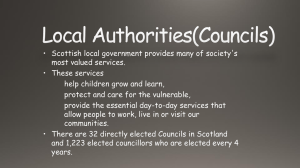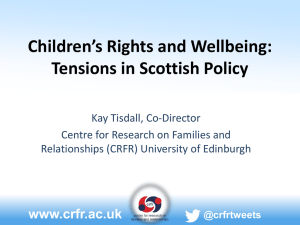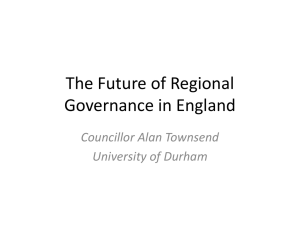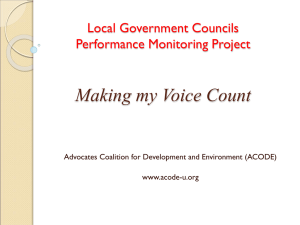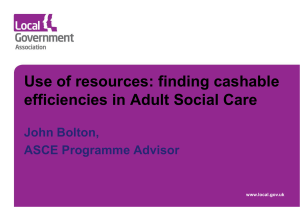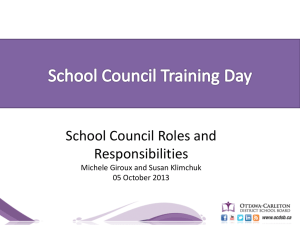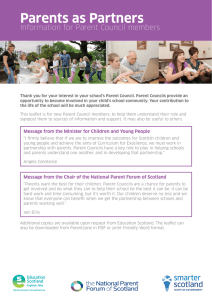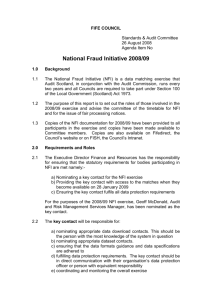13+ 30 March presentation Education Scotland
advertisement
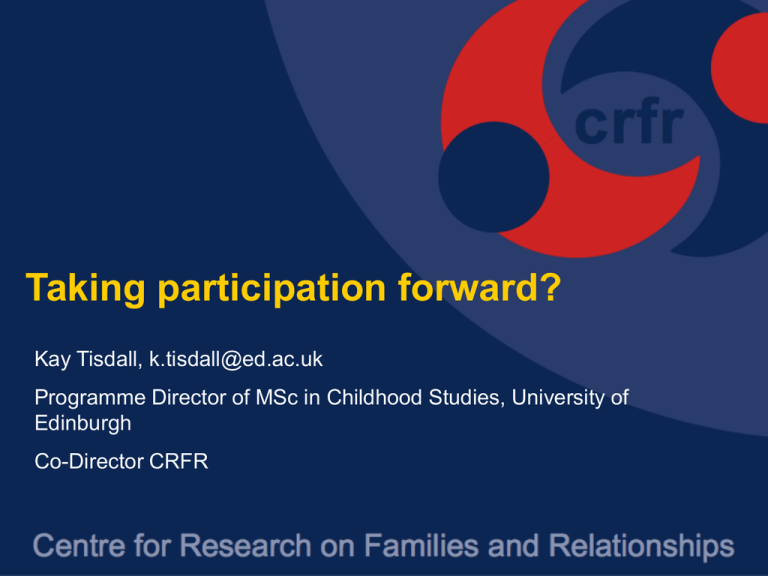
Taking participation forward? Kay Tisdall, k.tisdall@ed.ac.uk Programme Director of MSc in Childhood Studies, University of Edinburgh Co-Director CRFR What do we mean by participation? “This term has evolved and is now widely used to describe ongoing processes, which include information-sharing and dialogue between children and adults based on mutual respect, and in which children can learn how their views and those of adults are taken into account and shape the outcome of such processes.” UN Committee on the Rights of the Child (2009) General Comment No. 12, p. 3. Space: children must be given the opportunity to express views Voice: children must be facilitated to express their views Influence: the views must be acted upon, Audience: the views must be listened to as appropriate. Lundy, L. (2007),’‘Voice’ is not enough: conceptualising Article 12 of the United Nations Convention on the Rights of the Child’. British Educational Research Journal, 33(6), 927-942. Turning to the person next to you … Share an activity in your school (or setting) that supports children and young people’s participation. Taking Laura’s model … What works? What doesn’t work? Challenges for participation 1. 2. 3. 4. 5. Tokenism Lack of feedback Who is included or excluded Consultation but not dialogue Adults processes and structures exclude children and young people 6. Lack of sustainability From ESRC project – see www.crfr.ac.uk Why support children and young people’s participation in schools? (1) Upholding children’s rights and fulfilling legal responsibilities. UNCRC, Standards in Scotland’s Schools etc. Act 2000 S. 2(2), Children & Young People Bill? (2) Improving services and decision-making. (3) Democratic education. (4) Children and young people’s well-being and development. Making rights real … “We want a Scotland where the rights of children and young people are not just recognised, but rooted deep in our society and our public services. A nation that strives to make these rights real in our everyday lives.” Minister for Children & Young People in Scottish Government (2012) A Scotland for Children: A consultation on the Children and Young People Bill What are school/ pupil councils? “A school council is a representative group of pupils elected by their peers to discuss matters about their education and raise concerns with the senior managers and governors of their school.” School Councils Wales http://www.schoolcouncilswales.org.uk/en/fe/page_at.as p?n1=30&n2=31&n3=69 A typical meeting from the Having a Say at School research project … Artwork copyright of Tobias Cook Text from Children in Scotland and Tobias Cook, as part of the Having a Say at School project (CRFR/Children in Scotland). Councils of the Galaxy. • Pivotal role of adult adviser. How is this supported? • Purpose of council unclear and not agreed “The problem is with the School Council. It appears very good and it looks very good and everyone thinks it works well, but then we say things and we have ideas and they don’t go anywhere.” (School councillor School B) ‘Laboratory of democracy’ – A great deal of time – When selection is fair, councils more likely to be perceived as effective – Pupils not on councils want more information about their councils and what happens – The downside … matching purposes? “… I think the process in itself is worthwhile. Whereas for them [the school council] it’s probably the outcomes; it’s in their mind. But if we can get them some of their outcomes and allow them to take part in the process at the same time, I think that’s a reasonable tradeoff.” (Headteacher School A) • Governance. What connections are there with power in the school? • Outcomes. What do school councils discuss, make a decision on and do changes result? • The power of money. Does the school council have a budget? A selection of possible recommendations … • Ensure council elections ensure council elections are (and are perceived as) fair • Recognise and reward the school council’s adult adviser • Tighten the connections between school councils and school governance structures. • Continued dialogue between staff and pupils on what their school council is for • Continuing across academic years • Budgets • Improved communication between school councils and others in the school • All staff members being committed to the school council Opportunities for participation ... 1. Government commitment 2. Enthusiasm of the converted 3. Creative, inclusive and productive approaches 4. Use of technology. From ESRC project – see www.crfr.ac.uk More information on Having a Say at School … http://www.havingasayatschool.org.uk/promoting.html Tisdall, E.K.M. (2012) ‘Taking forward children and young people’s participation’, in Hill, M., Head, G., Lockyer, A., Reid, B. and Taylor, R. (eds) Children’s Services: working together, Harlow: Pearson, pp. 151-162. Tisdall, E.K.M. (2010) ‘Governance and Participation’, in Percy-Smith, B. and Thomas, N. (eds) A Handbook of Children and Young People’s Participation, London: Routledge, pp. 318-329. More information about participation in schools and school councils … • Education Scotland, of course • Cross, B, Hall, J., Hall, S., Hulme, M., Lewin, J., McKinney, S. (2009), Pupil Participation in Scottish Schools. University of Glasgow. http://eprints.gla.ac.uk/49601/ • http://www.pupilvoicewales.org.uk/ • http://www.niccy.org/Participation/democra2 More information on CRFR opportunities .. CPD courses on research and consultation with children and young people … • Using creative methods in research with children and young people 21st and 22nd March 2013 • Using digital media in research with children and young people18th and 19th April 2013 http://www.crfr.ac.uk/eventsandtraining/ MSc/Diploma in Childhood Studies http://www.sps.ed.ac.uk/pgtcs
